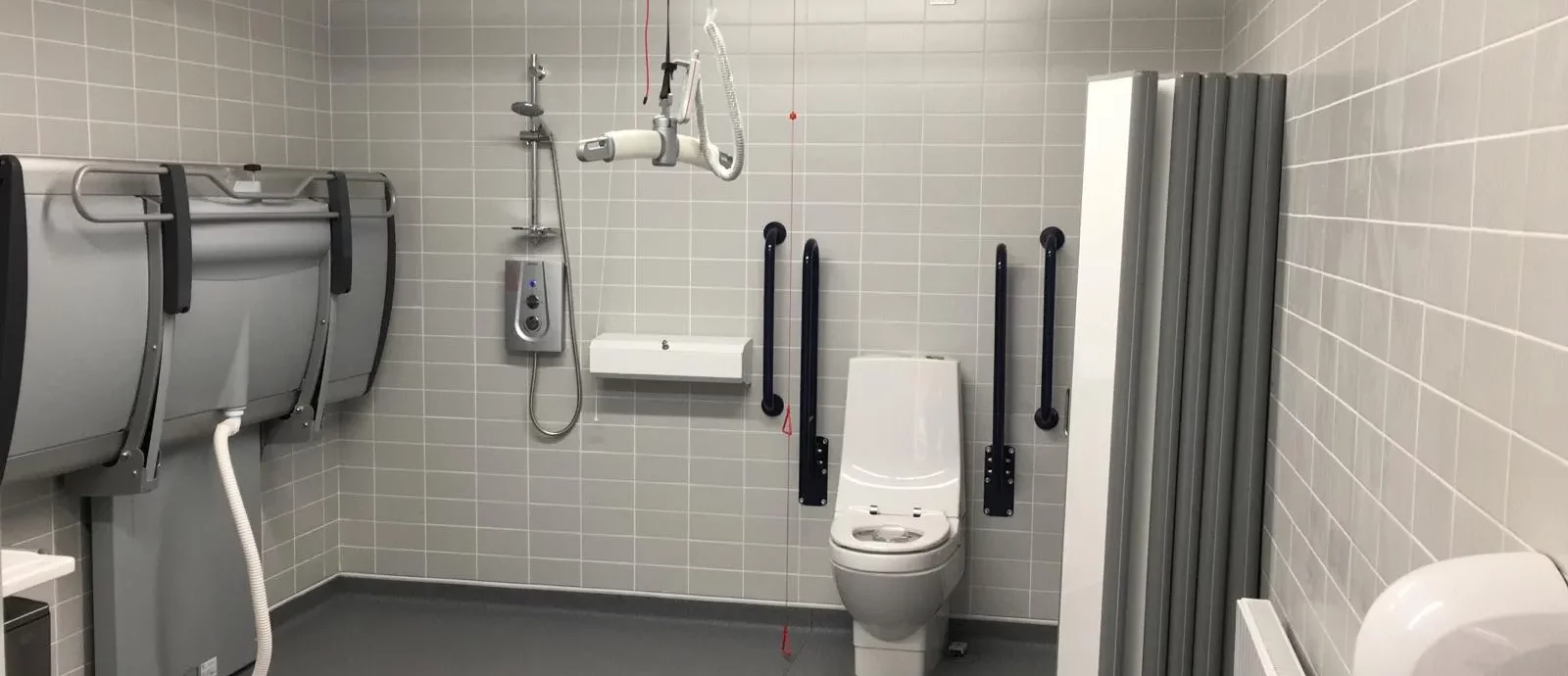Step 1: Understanding what a Changing Places toilet is
Before getting started, it’s essential to understand what makes a Changing Places toilet different from a standard accessible toilet. These facilities are larger and come with:
- A height-adjustable adult-sized changing bench
- A ceiling track hoist system
- Adequate space for the user and up to two carers
- A peninsular toilet
- A privacy screen or curtain
- Wide paper roll, a large waste bin, and a non-slip floor
These features ensure dignity, hygiene, and safety for users with profound and multiple learning or physical disabilities.

Step 2: Planning and Design
Assess Your Space
The recommended minimum size for a Changing Places toilet is 12 square metres (3m x 4m) with a ceiling height of at least 2.4 metres. You will need to evaluate whether you can retrofit an existing space or build an extension.
Consult the Guidelines
The official BS8300:2018 standards provide design guidance for accessibility, including specific layouts and dimensions for Changing Places toilets. The Changing Places Consortium also offers technical guides and layout templates to assist with planning, as does our team.
Engage Stakeholders
Consult with disability groups, carers, and potential users to ensure the facility meets their needs. Early engagement can also help gain public and local authority support.
Step 3: Securing Funding
Local Authority Grants
Some Scottish councils offer grants to support the installation of Changing Places toilets, particularly in community centres, transport hubs, and visitor attractions.
Government Schemes
Check the Scottish Government website for funding initiatives. For example, the Changing Places Fund has previously offered grants to improve accessible infrastructure in public buildings.
You can note your interest in applying for Changing Places funding on the PAMIS website.
Fundraising and Sponsorship
If public funds are limited, consider crowdfunding, partnering with local charities, or seeking sponsorship from local businesses invested in inclusion and accessibility.

Step 4: Construction and Installation
Once you’ve secured funding and finalised your design:
- Hire experienced contractors who understand the BS8300:2018 standards and can work with specialised equipment.
- Purchase certified equipment, such as hoists and changing benches, from trusted suppliers like Innova.
Ensure plumbing, ventilation, and electrical systems meet building and safety codes.
The construction phase can take several weeks, depending on the scope, but efficient project management and clear communication with contractors will ensure timely completion.
Step 5: Registering Your Facility
Once your Changing Places toilet is complete, the final step is to register it with the Changing Places Consortium. This makes your facility visible on national maps and search platforms, so disabled users and carers can find and access your toilet easily.
You’ll need to:
- Submit photos and layout diagrams
- Confirm that your facility meets all minimum requirements
- Provide location and access information (e.g. opening hours, keycode access, etc.)
Registration is free and significantly boosts the visibility of your facility within Scotland and beyond.
Summary
Installing a Changing Places toilet in Scotland is a powerful commitment to equality and inclusion. While the process requires careful planning and investment, the long-term benefits for individuals with disabilities, carers, and the wider community are immeasurable. By following this guide, you can take meaningful steps to make your venue truly accessible to all.
FAQs
Who needs a Changing Places toilet in Scotland?
People with complex disabilities who require extra equipment or space (such as hoists and changing benches) benefit from Changing Places toilets, which standard accessible toilets do not accommodate.
What is the minimum size for a Changing Places facility?
The minimum recommended size is 12m² (3m x 4m) with a ceiling height of 2.4m.
Are Changing Places toilets a legal requirement in Scotland?
Since 2022, certain new public buildings in Scotland have been required by law to include Changing Places facilities as part of building regulations.
How do I apply for funding to install a Changing Places toilet?
You can apply through local councils, government-backed funding schemes, or work with disability organisations for financial support and guidance.
How can users find my Changing Places toilet once it’s installed?
By registering your facility with the Changing Places Consortium, it will appear on national databases and mobile apps, making it easy for users to locate it.

